Ticket office 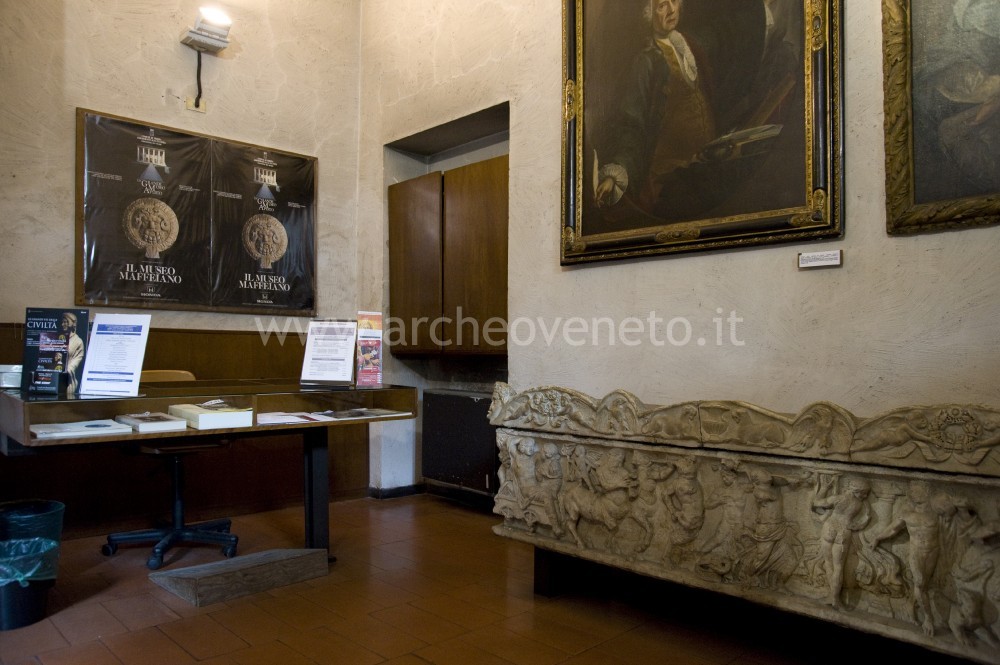 In the small room which hosts the ticket office there is a beautiful sarcophagus with a Bacchus procession (2nd century AD). Besides several epigraphs coming from different places and dating back to different times (including a fragment of an Egyptian hieroglyphic inscription engraved on a black basalt pillar), there is a display case with a fragment of a bronze table containing a decree of the Roman Senate (23 AD) and three Roman stamped bricks (2nd century AD). In the small room which hosts the ticket office there is a beautiful sarcophagus with a Bacchus procession (2nd century AD). Besides several epigraphs coming from different places and dating back to different times (including a fragment of an Egyptian hieroglyphic inscription engraved on a black basalt pillar), there is a display case with a fragment of a bronze table containing a decree of the Roman Senate (23 AD) and three Roman stamped bricks (2nd century AD). |
Greek room 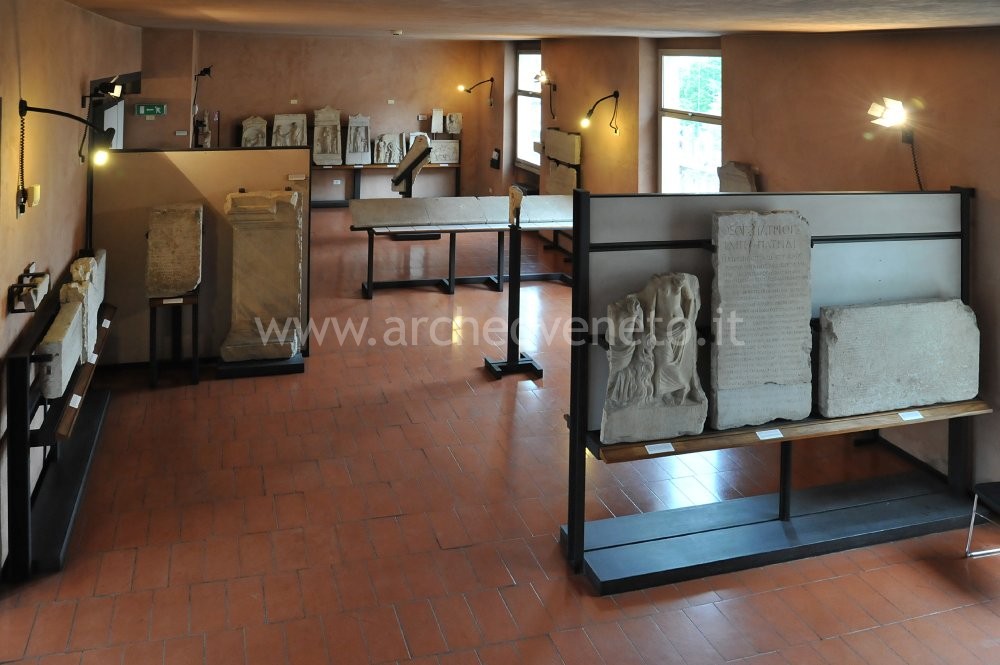 This room houses a large number (almost one hundred) of Greek inscriptions collected by Scipione Maffei during the 18th century. These findings were found here following the deep interest in antique collections shown by the Most Serene Republic of Venice which, during the 18th century, established trade relations with the territories where the Greek civilization was spread (Asia Minor, Cyclades Islands, Crete, Attica and Peloponnesus) .
The pieces displayed in this room mainly have a funerary function (although there are also bases of honorary statues, inscriptions related to public decrees and votive reliefs) and date back to a time span ranging from Classical period (5th century BC) and Late Antiquity (5th century AD).
At the very entrance of the room there is a portion of a statue depicting Meleager, standing and naked, which is likely to be a replica of the original one made by Skopas (1st century AD). The visit continues with the exhibition of some important epigraphs, including some public decrees.
On the left, there are bases of statues, the most important being the one erected by the people of Alexandria (and other Greek communities who lived in Egypt) in honour of the famous rhetorician Aelius Aristides in the 2nd century AD.
Behind the decrees there are votive reliefs, often depicting a young man standing who holds the bit of a horse, with a dedicator and a servant on his side. Noteworthy are a relief (5th century BC) from Attica with the above-described iconography and an opistrograph tablet from the 5th century depicting a bearded man and elements which recall the cult of Asclepius; its great value stems from the fact that it was part of the monument erected as part of the sanctuary of Asclepius in Athens.
In the middle of the room there are four tablets one next to the other (3rd century BC), originally placed on a base, with the last will and testament of a woman called Epikteta from Thera leaving instructions for the establishment of an association aimed at carrying on the heroic cult of herself and her family.
The last section of the room is devoted to funerary steles, most of which have a naiskos (small temple) structure and depict the deceased alone or with their beloved (including servants) while departing or busy in their chores. The most meaningful examples of this type of steles are: the funerary stele of Krinò (2nd century BC), where the deceased is depicted while offering a small box to a maidservant; a tablet from Smirne (2nd century BC), where the deceased takes his leave of a man by shaking his hand; a funerary inscription from Smirne (2nd century BC) made by the people in honour of Demò who is depicted in a standing position with a torch and a bunch of spikes together with two maidservants; a funerary stele of Archagathos from Rhenea (2nd-1st century BC), died in a sinking, which depicts the deceased sitting down on the rocks and watching the sea where some heads and the prow of a ship can be spotted; the funerary tablet of Eukleia (1st century BC), which depicts the deceased sitting on the left and two man on a kline (bed) and a maidservant (scene of a funeral feast) on the right; the funerary stele of Gaius Silius (1st century AD), depicting the boy deceased standing in the middle with a dog at his feet and a relief depicting theatrical masks hinting at the profession of actor behind him. This room houses a large number (almost one hundred) of Greek inscriptions collected by Scipione Maffei during the 18th century. These findings were found here following the deep interest in antique collections shown by the Most Serene Republic of Venice which, during the 18th century, established trade relations with the territories where the Greek civilization was spread (Asia Minor, Cyclades Islands, Crete, Attica and Peloponnesus) .
The pieces displayed in this room mainly have a funerary function (although there are also bases of honorary statues, inscriptions related to public decrees and votive reliefs) and date back to a time span ranging from Classical period (5th century BC) and Late Antiquity (5th century AD).
At the very entrance of the room there is a portion of a statue depicting Meleager, standing and naked, which is likely to be a replica of the original one made by Skopas (1st century AD). The visit continues with the exhibition of some important epigraphs, including some public decrees.
On the left, there are bases of statues, the most important being the one erected by the people of Alexandria (and other Greek communities who lived in Egypt) in honour of the famous rhetorician Aelius Aristides in the 2nd century AD.
Behind the decrees there are votive reliefs, often depicting a young man standing who holds the bit of a horse, with a dedicator and a servant on his side. Noteworthy are a relief (5th century BC) from Attica with the above-described iconography and an opistrograph tablet from the 5th century depicting a bearded man and elements which recall the cult of Asclepius; its great value stems from the fact that it was part of the monument erected as part of the sanctuary of Asclepius in Athens.
In the middle of the room there are four tablets one next to the other (3rd century BC), originally placed on a base, with the last will and testament of a woman called Epikteta from Thera leaving instructions for the establishment of an association aimed at carrying on the heroic cult of herself and her family.
The last section of the room is devoted to funerary steles, most of which have a naiskos (small temple) structure and depict the deceased alone or with their beloved (including servants) while departing or busy in their chores. The most meaningful examples of this type of steles are: the funerary stele of Krinò (2nd century BC), where the deceased is depicted while offering a small box to a maidservant; a tablet from Smirne (2nd century BC), where the deceased takes his leave of a man by shaking his hand; a funerary inscription from Smirne (2nd century BC) made by the people in honour of Demò who is depicted in a standing position with a torch and a bunch of spikes together with two maidservants; a funerary stele of Archagathos from Rhenea (2nd-1st century BC), died in a sinking, which depicts the deceased sitting down on the rocks and watching the sea where some heads and the prow of a ship can be spotted; the funerary tablet of Eukleia (1st century BC), which depicts the deceased sitting on the left and two man on a kline (bed) and a maidservant (scene of a funeral feast) on the right; the funerary stele of Gaius Silius (1st century AD), depicting the boy deceased standing in the middle with a dog at his feet and a relief depicting theatrical masks hinting at the profession of actor behind him. |
Roman and Etruscan room 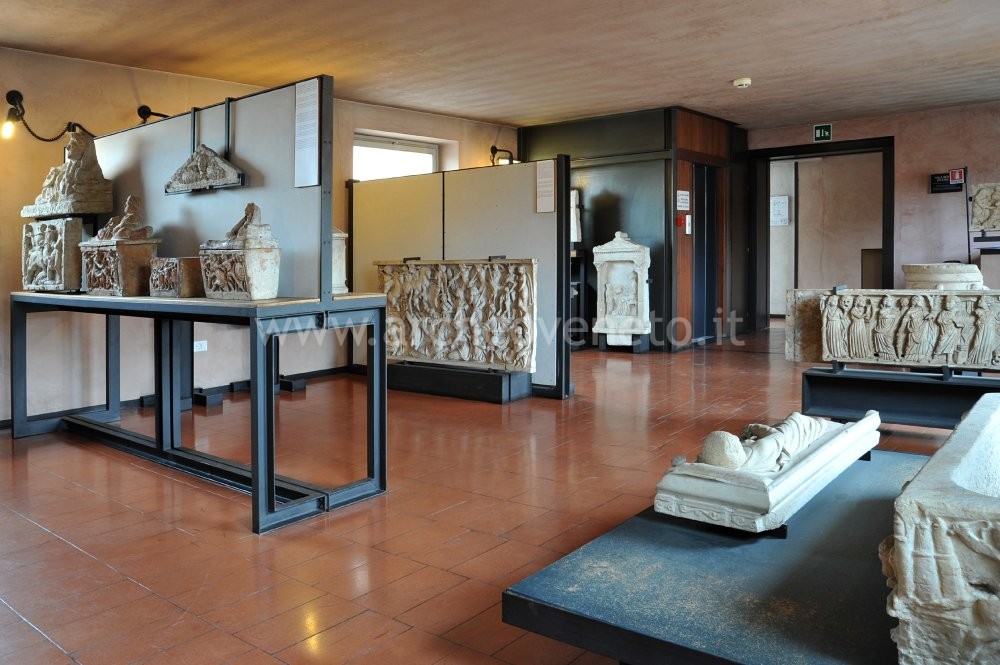 The room, situated on the second floor gathers and displays Roman sculptures and Etruscan cinerary urns from the excavations carried out in Central Italy.
At the very entrance of the room, there is a marvellous well-curb (Rome - 1st century BC) depicting a Dionysiac procession, with two groups of people walking towards a central altar. Next to this small ornamental element for wells, there are two fragments of tablets from a sarcophagus (2nd-4th century AD), depicting a scene of pancratium (fight) and a school. Noteworthy are the two beautiful front panels of a sarcophagus, probably from Rome and dating back to the 3rd century AD, depicting eight Muses with their typical symbols in their hands in front of a curtain and a marine procession moving towards the centre of the sarcophagus with the head of the deceased inside a shell, respectively.
On the same side of the room there are also a sarcophagus of a child with a two-horse chariot led by Cupid (Rome – 2nd century AD), the lid of a sarcophagus with a young deceased lying down with his head resting on two pillows (Rome – 3rd century AD) and an oscilla with the head of Jupiter Ammon at the front and a theatrical mask on the back (2nd century AD).
The visit continues with the display of unidentified funerary tables, tablets with votive reliefs and fragments of sarcophagi. Noteworthy are the votive relief depicting the god Mithras while killing a bull (Anzio – 2nd century AD) and the front panel of a sarcophagus with the myth of Phaeton, depicted while falling down from his father’s (Helios - Sun) cart (Rome - 3rd century AD). Particularly important in this room are the numerous Roman and Etruscan cinerary urns, with a rectangular and cylindrical shape, with inscriptions and decorations. Among the ones from the Roman Age, noteworthy is the one commissioned by Lucius Flavius Philopappus for his wife (1st century AD). There is also an interesting set of Etruscan cinerary urns collected by Jacopo Verità in the area around Verona (mid 18th century) with lids depicting the deceased in a half lying position, often with a patera, a fruit or a fan on his/her hand. Mythological themes (the abduction of Helena, fight between Eteocles and Polynices, Centauromachy) or scenes of funeral feasts are depicted on the sides of the urns made out of terracotta (Chiusi), alabaster (Volterra) or travertine (Perugia).
The last section of the room displays several funerary steles from Padua, with scenes of journeys to the underworld, where the deceased is depicted on a four-horse chariot led by a charioteer with his/her head covered. There are also two rocks (segnacolo) used to report the presence of a grave: a large ellipsoid pebble with a hole in the middle and Venetic inscription (Padua - 1st century AD) and a truncated-pyramid shaped stone with Venetic and Latin inscription.
Inside the room, there are also two display cases which house small-sized sculptures, some fragments of reliefs, bases of statues and theatrical masks from the Roman Age. The room, situated on the second floor gathers and displays Roman sculptures and Etruscan cinerary urns from the excavations carried out in Central Italy.
At the very entrance of the room, there is a marvellous well-curb (Rome - 1st century BC) depicting a Dionysiac procession, with two groups of people walking towards a central altar. Next to this small ornamental element for wells, there are two fragments of tablets from a sarcophagus (2nd-4th century AD), depicting a scene of pancratium (fight) and a school. Noteworthy are the two beautiful front panels of a sarcophagus, probably from Rome and dating back to the 3rd century AD, depicting eight Muses with their typical symbols in their hands in front of a curtain and a marine procession moving towards the centre of the sarcophagus with the head of the deceased inside a shell, respectively.
On the same side of the room there are also a sarcophagus of a child with a two-horse chariot led by Cupid (Rome – 2nd century AD), the lid of a sarcophagus with a young deceased lying down with his head resting on two pillows (Rome – 3rd century AD) and an oscilla with the head of Jupiter Ammon at the front and a theatrical mask on the back (2nd century AD).
The visit continues with the display of unidentified funerary tables, tablets with votive reliefs and fragments of sarcophagi. Noteworthy are the votive relief depicting the god Mithras while killing a bull (Anzio – 2nd century AD) and the front panel of a sarcophagus with the myth of Phaeton, depicted while falling down from his father’s (Helios - Sun) cart (Rome - 3rd century AD). Particularly important in this room are the numerous Roman and Etruscan cinerary urns, with a rectangular and cylindrical shape, with inscriptions and decorations. Among the ones from the Roman Age, noteworthy is the one commissioned by Lucius Flavius Philopappus for his wife (1st century AD). There is also an interesting set of Etruscan cinerary urns collected by Jacopo Verità in the area around Verona (mid 18th century) with lids depicting the deceased in a half lying position, often with a patera, a fruit or a fan on his/her hand. Mythological themes (the abduction of Helena, fight between Eteocles and Polynices, Centauromachy) or scenes of funeral feasts are depicted on the sides of the urns made out of terracotta (Chiusi), alabaster (Volterra) or travertine (Perugia).
The last section of the room displays several funerary steles from Padua, with scenes of journeys to the underworld, where the deceased is depicted on a four-horse chariot led by a charioteer with his/her head covered. There are also two rocks (segnacolo) used to report the presence of a grave: a large ellipsoid pebble with a hole in the middle and Venetic inscription (Padua - 1st century AD) and a truncated-pyramid shaped stone with Venetic and Latin inscription.
Inside the room, there are also two display cases which house small-sized sculptures, some fragments of reliefs, bases of statues and theatrical masks from the Roman Age. |
Courtyard and pronaos 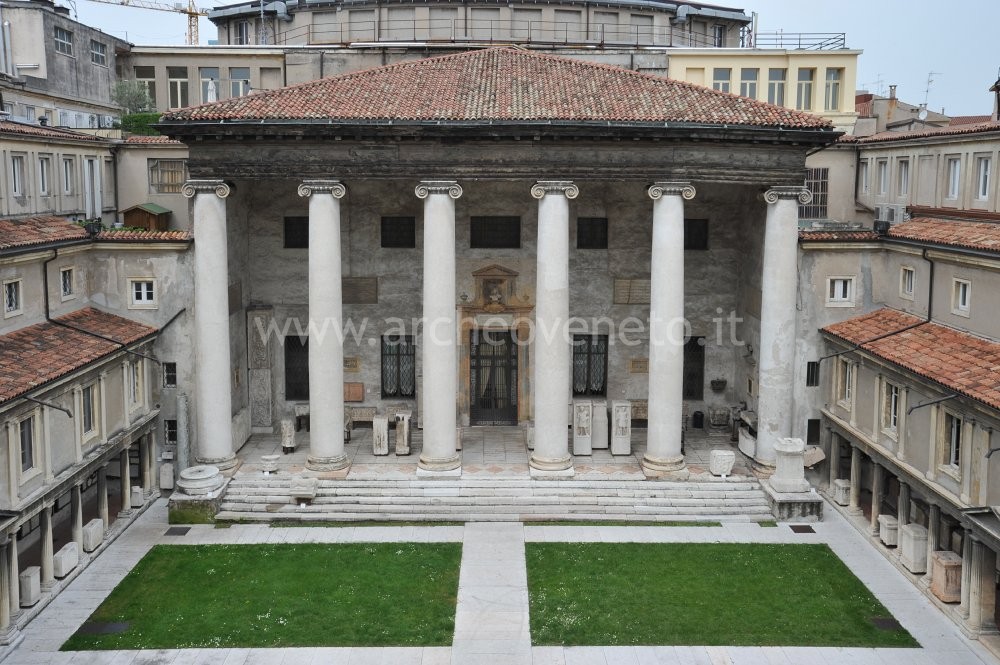 The wide courtyard of the Philharmonic Theatre hosts a rich epigraphic collection, which has been divided into smaller sections to make it easier to visit: exedras, portico on the right, pronaos and portico on the left.
In the two exedras, next to the entrance, numerous milestones (stones placed along the roads to measure the distance) from the area around Verona are exhibited. Noteworthy are a group of milestones from via Postumia (made in 148 BC) and another group from the 4th century AD, when several Roman arterial roads were rebuilt or renovated.
Inside the portico on the right there are inscriptions from Verona and its surrounding area, including funerary and votive epigraphs and bases of statues.
The pronaos, at the end of the courtyard, houses several memorial tablets and stones collected in different areas and of different nature: front panels of Etruscan small urns, Greek inscriptions, fragments of funerary monuments, boundary stones and parts of architectonical decorations (pillars decorated with acanthus scrolls, keystone with the head of Jupiter Ammon). Over the door in the middle of the pronaos there is the bust of the scholar Scipione Maffei from Verona, to whom the museum is dedicated. Inside the portico on the left there are numerous inscriptions, mainly funerary ones, from different areas (Padua, Rome, Dalmatia, Istria, Aquileia). The wide courtyard of the Philharmonic Theatre hosts a rich epigraphic collection, which has been divided into smaller sections to make it easier to visit: exedras, portico on the right, pronaos and portico on the left.
In the two exedras, next to the entrance, numerous milestones (stones placed along the roads to measure the distance) from the area around Verona are exhibited. Noteworthy are a group of milestones from via Postumia (made in 148 BC) and another group from the 4th century AD, when several Roman arterial roads were rebuilt or renovated.
Inside the portico on the right there are inscriptions from Verona and its surrounding area, including funerary and votive epigraphs and bases of statues.
The pronaos, at the end of the courtyard, houses several memorial tablets and stones collected in different areas and of different nature: front panels of Etruscan small urns, Greek inscriptions, fragments of funerary monuments, boundary stones and parts of architectonical decorations (pillars decorated with acanthus scrolls, keystone with the head of Jupiter Ammon). Over the door in the middle of the pronaos there is the bust of the scholar Scipione Maffei from Verona, to whom the museum is dedicated. Inside the portico on the left there are numerous inscriptions, mainly funerary ones, from different areas (Padua, Rome, Dalmatia, Istria, Aquileia). |
Basement 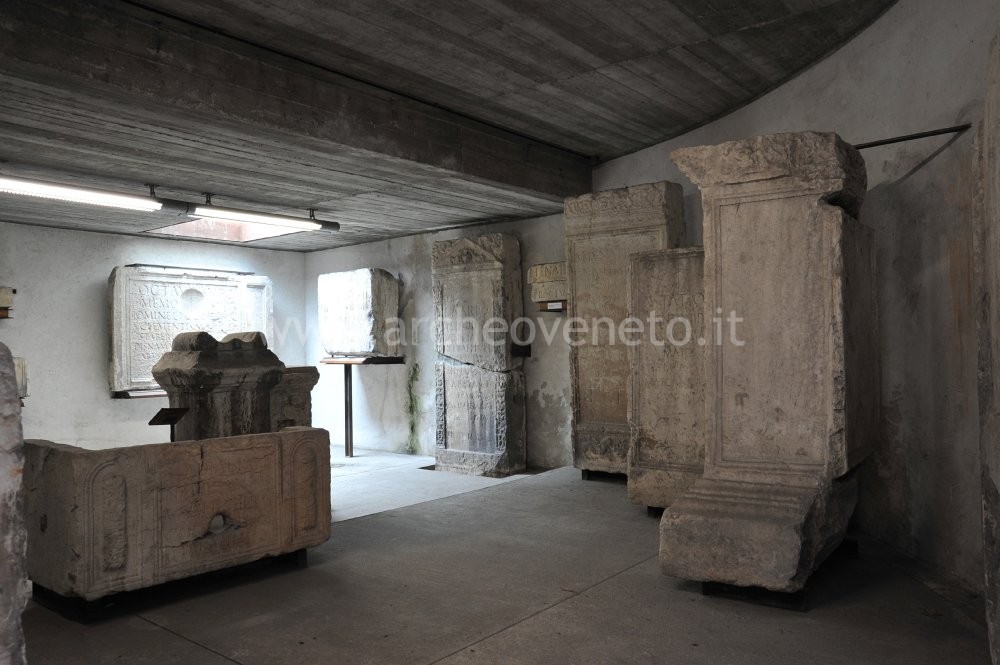 The basement, which can be visited on demand, hosts important inscriptions from the surroundings of Verona, Brescia and Trento.
The first section exhibits some gravestones from the area around Verona dating back to 1st-2nd century AD (tablets, sarcophagi, steles, altars and stones) and carved in the local white or pink marble.
The second section hosts inscriptions from the territory of the ancient pagus of the Arusnates people (current Valpolicella) showing the different aspects of life and the religious rituals of this community. The basement, which can be visited on demand, hosts important inscriptions from the surroundings of Verona, Brescia and Trento.
The first section exhibits some gravestones from the area around Verona dating back to 1st-2nd century AD (tablets, sarcophagi, steles, altars and stones) and carved in the local white or pink marble.
The second section hosts inscriptions from the territory of the ancient pagus of the Arusnates people (current Valpolicella) showing the different aspects of life and the religious rituals of this community. |
|
Visiting
Admission: Negli orari di apertura;
Ticket: Si;
Price: Full fare 4,50 €; Reduced fare (groups, students, seniors 60+) 3,00 €; Reduced fare (schools and children aged between 8-14, only with escort) 1,00 €; Full fare: Museum + Roman Amphitheatre 7,00 €; Reduced fare: Museum + Roman Amphitheatre 5,00 €; Senior Verona citizens 65+ free; Mantova - Verona Card free; Verona Card (1 day) 10,00 €; Verona Card (3 days) 15,00 €.;
 School access School access
 Disabled access Disabled access
|
| Tipology | When | Specs |
|---|
| Summer/Winter | Tuesday | 08.30 – 14.00 | | Summer/Winter | Wednesday | 08.30 – 14.00 | | Summer/Winter | Thursday | 08.30 – 14.00 | | Summer/Winter | Friday | 08.30 – 14.00 | | Summer/Winter | Saturday | 08.30 – 14.00 | | Summer/Winter | Sunday | 08.30 – 14.00 |
The access to the basement is allowed only on request
Recommended tour time (minutes): 75
|
|
Services for visitors
 Toilet Toilet
 Bookshop Bookshop
 Rest points Rest points
|
Educational Services
 Brochure
Catalogo
Guide a stampa Brochure
Catalogo
Guide a stampa
Italian, English, German
 Information boards Information boards
Italian
 Mobile cards Mobile cards
Italian, English, German, French
 Captions under exhibits Captions under exhibits
Italiano, English
 Multilingual ads: Tedesco
Francese
Inglese Multilingual ads: Tedesco
Francese
Inglese
Information sheets and captions
 Guided Tours Guided Tours
Contact the numerous associations of authorized guides of Verona for guided tours for adults in Italian or foreign languages.
 Educational activities Educational activities
Dal lunedì al venerdì: ore 9.00-13.00 e 14.00-16.15
Tel 045 8036353 - Tel/fax 045 597140 - Fax 045 8000466
aster.segreteriadidattica@comune.verona.it - www.didamusei.it
Prezzo: 1 ora: 46,00 €; 1,5 ore: 56,00 €; 2 ore: 66,00 €; 3 ore: 92,00 €; 1 giornata: 138,00 €.
Eventuali offerte saranno comunicate al momento della prenotazione.
I percorsi didattici sono offerti gratuitamente (fino ad esaurimento della disponibilità) alle Scuole del Comune di Verona. L’ingresso ai musei è a pagamento, con la tariffa ridotta per le scuole.
 Library and documentation centre Library and documentation centre
The library is situated in Castelvecchio.
|
| Ritti T. 1981, Iscrizioni e rilievi greci nel Museo Maffeiano di Verona, Roma . |
| Maganato L. 1982, Il Museo Maffeiano riaperto al pubblico, Verona. |
| Modonesi D. 1990, Museo Maffeiano: urne etrusche e stele paleovenete, Bergamo. |
| Il Museo Maffeiano: sezione paleoveneta, sezione etrusca, sezione greca, sezione romana: schede guida 1993, a cura di Modonesi D., Tonellotto A., Verona. |
| Modonesi D. 1995, Museo Maffeiano: iscrizioni e rilievi sacri latini, Roma. |
| Bolla M. 2000, Museo Lapidario Maffeiano , in Archeologia a Verona, a cura di Bolla M. , Milano, pp. 76-84. |
| Musei e raccolte archeologiche del Veneto 2004, a cura di Di Mauro A., Dosson di Casier, pp. 112-113. |
| Bonetto J. 2009, Veneto (Archeologia delle Regioni d'Italia), Roma, pp. 356-357. |
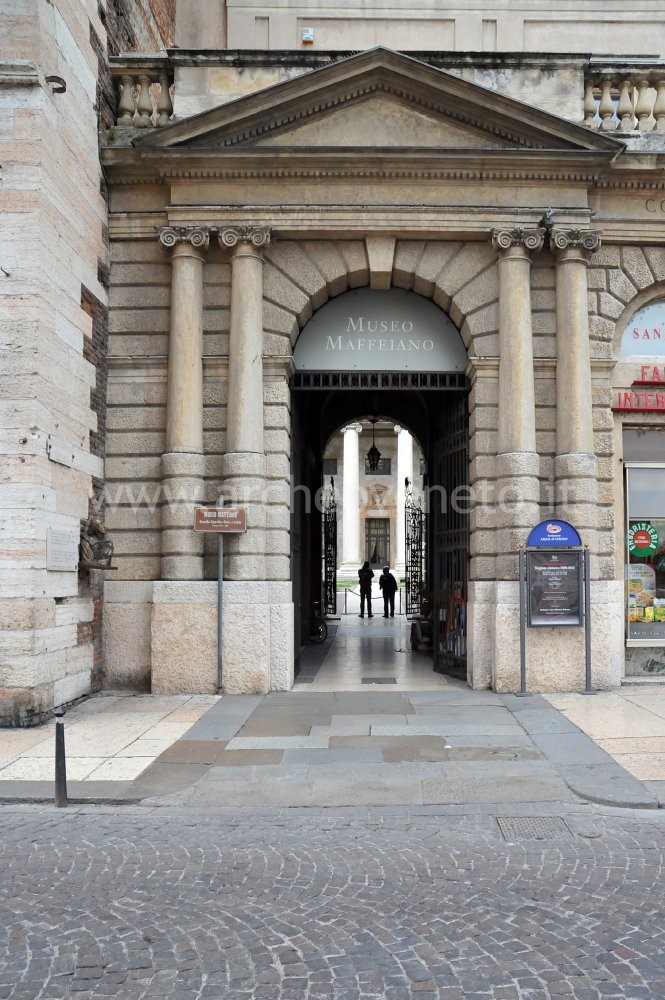
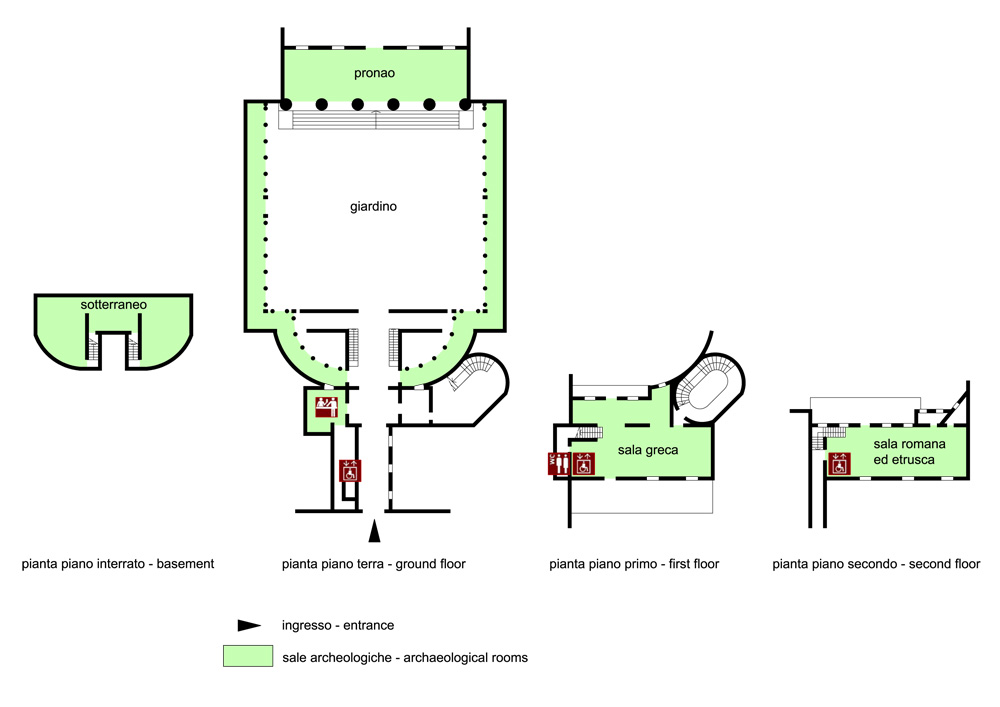
 School access
School access
 Disabled access
Disabled access
 Toilet
Toilet Bookshop
Bookshop Rest points
Rest points Brochure
Catalogo
Guide a stampa
Brochure
Catalogo
Guide a stampa Information boards
Information boards Mobile cards
Mobile cards Captions under exhibits
Captions under exhibits Multilingual ads: Tedesco
Francese
Inglese
Multilingual ads: Tedesco
Francese
Inglese Guided Tours
Guided Tours  Educational activities
Educational activities Library and documentation centre
Library and documentation centre



